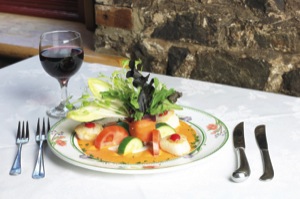
Being in the food and beverage industry and writing about it, I often get asked how to pair food and wine. Simply answered, pairing food and wine does take some type of knowledge, but it also takes imagination and is a lot of fun.
When I first started learning about wine, I was in my late teens and working for a brilliant man who began to train my senses to understand taste and smell. The senses of taste and smell are so closely linked that we always taste what we smell and vice versa. The two work in conjunction and play a huge interlinked role when it comes to pairing wines with food.
When you think about it, the taste elements of both food and wine are relatively the same. Sweetness, acidity, bitterness and astringency are just some of the descriptors we use when talking about food and wine.
The analogies between food and wine are endless. Food, like wine, needs to be grown in good soils with enough sunlight and rain. Just as there are different grape varieties, there are different varieties of tomatoes, mushrooms and apples to name just a few. Each variety is then further differentiated by its origins.
Just like winemaking techniques, cooking methods can change the original flavors of food. This of course greatly varies the choice when it comes to wine pairing. Just like wine making techniques can change the taste of the grape.
Take Chardonnay for example. If it is fermented and aged in oak barrels, it will taste oakier. If malolactic fermentation is allowed, it will taste more buttery. If it is aged in stainless steel, it will taste more acidic. What this means is that you can’t say that Chardonnay always goes with such and such dish, but rather you should identify a particular style and match it with foods that emulate that style.
When it comes to pairing food and wine, I often tell people there are no rules. People leaned on these rules of “white with chicken red with beef” because they are afraid they don’t know how to taste. With rules you don’t have to think, you don’t have to taste, all you need to do is follow the rules.
What might best be said is that taste is subjective. If one puts together a combination and people like it, it should be an acceptable combination. There may be no rules, but there are guidelines that are simply laws of nature and of chemistry.
Here are some quick rules of thumb when pairing wine and food together. Acid and bitter tastes reinforce each other. Sweet tastes change acidic and bitter tastes, as well as salty tastes. For example, sweet wines with salty foods work, whereas tannic or high alcoholic reds with salty foods taste bitter. Think of sitting at a bar eating salty nuts; you wouldn’t want to drink a big heavy red with them, but rather a crisp white such as a Riesling.
Now, the bitterness and acidity of a tannic red will make fish or creamy cheese taste metallic. But the lightness and fruitiness of a non tannic red will make fish and creamy cheese sing. If in a match both the personalities of the food and the wine are complimented, success has been achieved.
Think out of the box when you are home or out in a restaurant. Once you start to understand the flavor profiles of all the different wines out there you will be able to better understand what to eat with them. If you think about it, we all know what a hamburger tastes like, or fried chicken, or a grilled steak. Most of us have mastered understanding what foods we like and why.
My best recommendation to anyone wanting to learn how to perfectly pair wine with food is simply trial and error. Do some research. Think about how your food is prepared, not just what the food is. Grilled white meats for example may take a white wine, but often the cooking method means the dish can move up to a red, but only if it is soft and smoothly textured like a red Burgundy or Chinon.
Whatever the case, drink and eat what you like. Remember there are no rules, just guidelines. And if all else fails … there is always Champagne.











